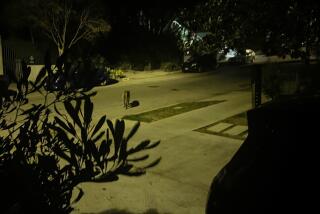On a Wing and a Prayer : Raptor’s Best Friend Helps Birds Rise Above Inhumanity
- Share via
VILLA PARK — Marge Gibson held a red-tailed hawk to her chest and stroked the feathers beneath the bird’s curved beak. Usually a fearsome predator, the red-tail was half-starved and helpless, a victim of a gunshot wound.
“I apologize for my species,” Gibson told the bird softly. “They’re really stupid.”
A bullet to the wing had made it impossible for the bird to fly--and to catch food. Gibson speculated that the hawk had dragged her wing around for a week, packing dirt in the hollow bone, before being found and brought to her convalescent hospital.
Gibson sees a lot of birds of prey with bullet wounds. The red-tail was the 10th this year. Frequently, they are brought in with broken wings, on the verge of starvation. Gibson takes them to a veterinarian for surgery and tries to nurse them back to health at her Villa Park home.
Frequently she fails. The red-tail brought in in February died of infection. Seven others also died.
But on Tuesday, Gibson’s efforts paid off as three of her former patients--two red-tailed hawks, both wounded by gunshots last December, and a golden eagle found with a fractured wing 18 months ago--were released back to the wild in the undulating, pristine hills of South County.
Accompanied by Marge Frost, a San Juan Capistrano resident who found one of the hawks lying in a South County street, Gibson drove to an isolated ridge near Caspers Regional Park and, one by one, helped release the birds back to the hills.
Gibson likened the short ceremony to a mother rearing children and finally, reluctantly, watching them leave home. There becomes a point, she said, when you just “have to let it go.”
Gibson said the red-tailed hawk, the American kestrel falcon, the Cooper’s hawk, the sharp-shinned hawk and the great-horned owl--or raptors, as they are collectively known--are not endangered species. But these Orange County birds are protected by federal and state law because their numbers are dwindling.
“I feel a lot of people take potshots at birds, not necessarily to kill them, but just to see them more closely,” Gibson said. “They’re big birds. It’s kind of a curiosity to see something that big and that strong.”
“You look at the grace and elegance” of the birds of prey, she said. “And it’s just such a waste--for senseless target practice.”
Gibson, whose license plate reads LDYHAUK, is a falconer who gained national recognition for rehabilitating raptors. Nearly a year ago, she studied the effects of the Valdez oil spill on golden eagles and bald eagles in Alaska for 2 1/2 months.
The Valdez spill was a terrible disaster, she said, but it provided researchers a chance to educate the public about the dangers man poses to wildlife.
She often conducts lectures on the need to respect and protect the beauty of wildlife and to recognize birds as a resource in Orange County’s ecosystem.
Injured raptors are often brought to her Villa Park safehouse by people who find them. The number of raptors hit by gunfire, she said, rises just after Christmas. In 1989, for example, of the 53 raptors brought to her with bullet injuries, 38 came in in the first five weeks of the year.
In all, 11 were shot this year within a few weeks after the holidays.
Jan Yost, a warden with the state Department of Fish and Game, suspects culprits are youngsters who get guns for Christmas and are quick to try them out.
“Kids get pellet guns or shotguns for Christmas, and their dads don’t have the time to take them out” and show them proper use, Yost said.
With its bucolic beauty and large rodent population, Orange County is the natural home year-round for hundreds of raptors. Hundreds of others winter here. But as development pushes farther into their habitat, the birds face ever more threats.
Tree-trimmers disturb their nests. Pesticides poison their young. Mirror-glass buildings become virtually invisible obstructions for the birds who otherwise see seven times more powerfully than humans.
“It’s bad enough that we live in their back yard,” said Scott Weldy, an El Toro veterinarian who operates on the wounded raptors. “I don’t think we have to shoot or destroy them.”
Before being released, two of Gibson’s adopted red-tails had been kept in a box-like enclosure, called a mew, on gravel which covers what used to be a back-yard tennis court. A third red-tail is convalescing in the mew.
With a wingspan of up to 4 1/2 feet, the two-pound red-tail swoops down on its prey at speeds of 180 miles per hour, diving hundreds of feet. A brown-and-cream-speckled bird with 12 rust-colored tail feathers, the red-tail can live for 30 years, Gibson said.
Throughout history, hawks have been mythologized and revered for their prowess and rarity. Falconers coveted them. Peasants worshiped them. Storytellers immortalized them.
And hunters destroyed them.
“It’s the macho thing to shoot them because they’re hawks. But they’re so big, you can’t miss” when you shoot at them, Gibson said. “Is that macho?”
More to Read
Sign up for Essential California
The most important California stories and recommendations in your inbox every morning.
You may occasionally receive promotional content from the Los Angeles Times.













